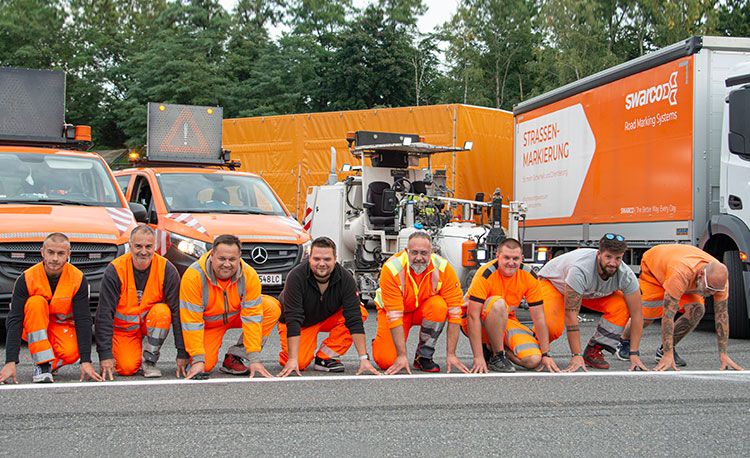Automated Driving: Road Markings in Practice Tests
SWARCO Road Marking Systems tests and applies marking systems in St. Valentin, Austria, as an exclusive partner of Digitrans.
At the new Digitrans test site in St. Valentin, the future of individual mobility undergoes extensive practice studies. As an exclusive partner, SWARCO Road Marking Systems is in charge of the marking systems, demonstrating its system expertise. The premium glass beads developed by SWARCO Road Marking Systems ensure high retroreflection of the marking materials, which are produced in-house, too. SWARCO Road Marking Systems also handles their application on the test track with the help of its own striping companies, using four different systems. The goal is to further improve visibility of road markings for autonomous driving systems.

SWARCO Road Marking Systems’ striping experts at work on the Digitrans test track in St. Valentin
16 December 2021 – The future of individual mobility belongs to autonomous driving. Nowadays, semi-autonomous driver assistance systems are already an integral part of modern vehicles. For these systems to be reliable, the quality of lane markings is crucial. “In the field of marking systems, SWARCO Road Marking Systems is one of the pioneers worldwide when it comes to system expertise. It is this expertise that we are able to demonstrate on the new Digitrans test track in different traffic scenarios,” says Friedrich Wiesinger, Team Leader Product Development at SWARCO Road Marking Systems.
Marking Materials, Glass Beads and Application from a Single Source
On the Digitrans test track in St. Valentin, SWARCO Road Marking Systems is responsible for the entire system expertise regarding the markings. “We do research and development, production, and application – in this way, we can ensure high quality all the way to the application of the markings on the road,” Wiesinger explains. In St. Valentin, four striping teams are involved in the tests. Two teams are in charge of the plain markings, one team takes care of the structured markings, and another one, of the area markings. The marking materials and glass beads used are developed in-house.
A Wide Variety of Marking Systems for a Broad Range of Applications
The tests in St. Valentin are among the most comprehensive cross-company practice trials relating to semi-autonomous systems that are currently undertaken. SWARCO Road Marking Systems uses different systems for the testing: “For plain markings, we use SWARCOFLEX in combination with cold spray plastics. For orange construction zone markings, we leverage the benefits of SWARCO SOLIDPLUS premium reflective glass beads. These premium glass beads are also used for structured markings where they are combined with cold plastics. For area markings, we rely on SWARCO SOLIDPLUS, too, but vary the system depending on the respective requirements,” Wiesinger explains. When it comes to area markings, the combination of SWARCO SOLIDPLUS and cold spray plastics is ideal for stop lines and directional arrows. For pedestrian crossings, SWARCO Road Marking Systems has even been testing two systems. “Here, we use the combination of SWARCO SOLIDPLUS 100 and roller plastics on one half and apply SWARCO SOLIDPLUS 10 together with cold spray plastics to the other half,” Wiesinger describes. The goal is to further optimize how sensors, and road and marking detection interact and work together.
Quality products and services from SWARCO Road Marking Systems guide traffic safely from A to B by day and, above all, by night.
On all types of roads. Whatever the weather. From a single source. Over 5,000 customers in more than 80 countries place their trust in them.
For further information visit: www.swarco.com/autonomous-driving
www.swarco.com/rms